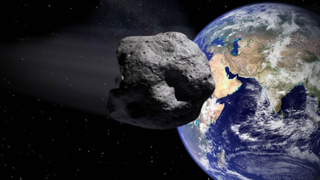Rare dark-streaked meteorites may come from a 'potentially hazardous' asteroid
The unusual shock-darkened meteorites came from a fireball over Chelyabinsk, Russia, in 2013.

Strange, dark-veined meteorites rained down on Earth when a fireball exploded over Chelyabinsk, Russia, in February 2013. The origin of these unusual meteorites has remained a mystery, but now, planetary scientists have discovered a possible source: a mile-and-a-half-long near-Earth asteroid.
Scientists know that the dark streaks across the Chelyabinsk meteorites are caused by a process called shock darkening. Yet only around 2% of a common type of meteorite called chondrite meteorites show signs of shock darkening, and the source of these space rocks has remained a mystery.
Now, scientists have identified the asteroid 1998 OR2 as a potential source of shock-darkened meteorites. The near-Earth asteroid was discovered in July 1998 by the Near-Earth Asteroid Tracking program at NASA's Jet Propulsion Laboratory. Its last close approach to Earth was in April 2020, when the space rock passed within 3.9 million miles (6.3 million kilometers) of our planet.
Related: Mile-long asteroid 1998 OR2 dons 'mask' before Earth flyby (photos)
Although that may not seem very close, NASA still considers 1998 OR2 "potentially hazardous" because changes to the asteroid's orbit over the next 1,000 years could make it a risk to Earth.
Meteorites are created when pieces of an asteroid like 1998 OR2 break away and enter Earth's atmosphere. The discovery that shock-darkened meteorites can originate from a near-Earth asteroid hints at the varying material strength of asteroids and has implications for protecting Earth against a potential impact, the researchers said.
"Shock darkening is an alteration process caused when something impacts a planetary body hard enough that the temperatures partially or fully melt those rocks and alter their appearance both to the human eye and in our data," Adam Battle, a graduate student in planetary science at the University of Arizona and lead author of the study, said in a statement. "This process has been seen in meteorites many times but has only been seen on asteroids in one or two cases way out in the main asteroid belt, which is found between Mars and Jupiter."
Get the Space.com Newsletter
Breaking space news, the latest updates on rocket launches, skywatching events and more!
Vishnu Reddy, a planetary scientist at the University of Arizona and co-author of the new study who detected shock darkening on these main-belt asteroids, said that it's a much more common phenomenon on asteroids than meteorites. "Impacts are very common in asteroids and any solid body in the solar system because we see impact craters on these objects from spacecraft images," he said in the statement. "But impact melt and shock-darkening effects on meteorites derived from these bodies are rare."
Reddy, who co-leads the Space Domain Awareness lab at the Lunar and Planetary Laboratory, added that finding a near-Earth asteroid dominated by this process has implications for impact hazard assessment.
"Adam [Battle]'s work has shown that ordinary chondrite asteroids can appear as carbonaceous in our classification tools if they are affected by shock darkening," Reddy said. “These two materials have different physical strengths, which is important when trying to deflect a hazardous asteroid."
Is asteroid 1998 OR2 chondrite or carbonaceous?
Reddy, Battle and their team used the Rapid Astronomical Pointing Telescopes for Optical Reflectance Spectroscopy (RAPTORS) atop the Kuiper Space Sciences Building on the University of Arizona campus to observe the asteroid 1998 OR2.
The team collected data on 1998 OR2's surface composition, with the asteroid visually appearing as an ordinary chondrite asteroid, a type of space rock that is light in color and contains the minerals olivine and pyroxene. But an asteroid classification tool determined that 1998 OR2 appeared to be a carbonaceous asteroid ; these space rocks are dark and featureless compared with chondrite asteroids.
The team then set about investigating the reason for this discrepancy and determining the correct classification.
"The mismatch was one of the early things that got the project going to investigate potential causes for the discrepancy," Battle said.
They eliminated the possibility that exposure to the space environment had caused changes in the asteroid's surface, as this process, called space weathering, would have left the space rock slightly reddened.
The team concluded that shock darkening was responsible for the disparity between the two analysis methods, because the shock darkening process can obscure olivine and pyroxene while darkening the asteroid's surface, thus making it look like a carbonaceous asteroid.
"The asteroid is not a mixture of ordinary chondrite and carbonaceous asteroids, but rather it is definitely an ordinary chondrite, based on its mineralogy, which has been altered — likely through the shock darkening process — to look like a carbonaceous asteroid to the classification tool," Battle said.
Shock darkening of asteroids was first theorized in the late 20th century but wasn't an intense area of study until the 2013 Chelyabinsk fireball seeded Earth with shock-darkened meteorites.
Interest in shock darkening grew after Reddy found asteroids affected by the process in the main asteroid belt. This new discovery showing evidence of the process in a near-Earth asteroid could further increase interest in shock darkening, the team said.
The research was published Oct. 4 in The Planetary Science Journal and presented at a conference held this week by the American Astronomical Society's Division of Planetary Sciences..
Follow us on Twitter @Spacedotcom or on Facebook.
Join our Space Forums to keep talking space on the latest missions, night sky and more! And if you have a news tip, correction or comment, let us know at: community@space.com.

Robert Lea is a science journalist in the U.K. whose articles have been published in Physics World, New Scientist, Astronomy Magazine, All About Space, Newsweek and ZME Science. He also writes about science communication for Elsevier and the European Journal of Physics. Rob holds a bachelor of science degree in physics and astronomy from the U.K.’s Open University. Follow him on Twitter @sciencef1rst.
Most Popular

